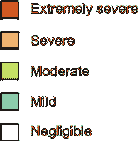
 |
The following map was very freely constructed from the Millennium map of UK corrosion of zinc.


UK Government figures released recently show urban air quality was the best since records began. In urban areas in year 2000, there were 17 days of moderate or higher air pollution on average per site, compared to 30 days in 1999 and 23 in 1998. The main causes of moderate or higher air pollution at urban sites are ozone, particulate matter and sulfur dioxide. The UK established National Air Quality Standards in 1993. The standards represent defined levels which avoid significant risks to health. As levels increase above the standard, the likelihood of effects on health increases. Levels of ozone in the high band may cause coughing and discomfort on deep breathing during exercise in some people. In some North American cities, the problem has been attributed to premature deaths. In Toronto, for example, 1,000 people died and another 5,500 were hospitalized in 2000 because of air pollution, according to the Toronto Board of Health.
The United Kingdom has emphasized pollution control rather than pollution prevention in its environmental policy-making. The British recently have distinguished themselves among the industrialized nations in environmental policy-making through the adoption of an integrated approach to pollution prevention that collectively regulates all types of pollution from a single source. Environmental policies in the U.K. have involved the use of direct regulation, economic instruments, and international agreements. The U.K. has made an effort to adopt and implement all EC environmental directives and increasingly is a strong supporter of an even more integrated European environmental program.
As in all the other nations we have considered, despite some improvements in air quality over the previous two decades, air pollution in the United Kingdom, particularly in urban areas, continues to increases as a result of the growth in motor vehicle use (in 1970 there were some 10 million passenger cars in the country, by 1994 there were well over 20 million). The transport infrastructure has increased over this time period as well. Currently, road transport accounts for over 90 percent of passenger travel within Britain and for over 80 percent of freight delivery and the amount of traffic per year has nearly doubled. For six of the eight air pollutants identified in the air quality strategy, transport is either the major source, or a significant source, of these pollutants in urban areas.
Other regions and countries: Argentina, Brazil, Canada, Central America, Chile, China, Colombia, Cuba, France, Germany, India, Italy, Japan, Mexico, New Zealand, North America, Portugal, Russia, Saudi Arabia, South Africa, Spain, Sweden, UK, USA, Venezuela
 |  |